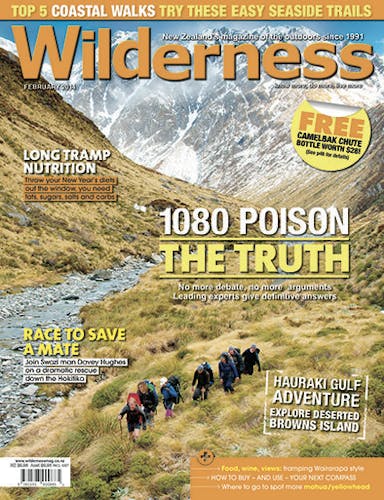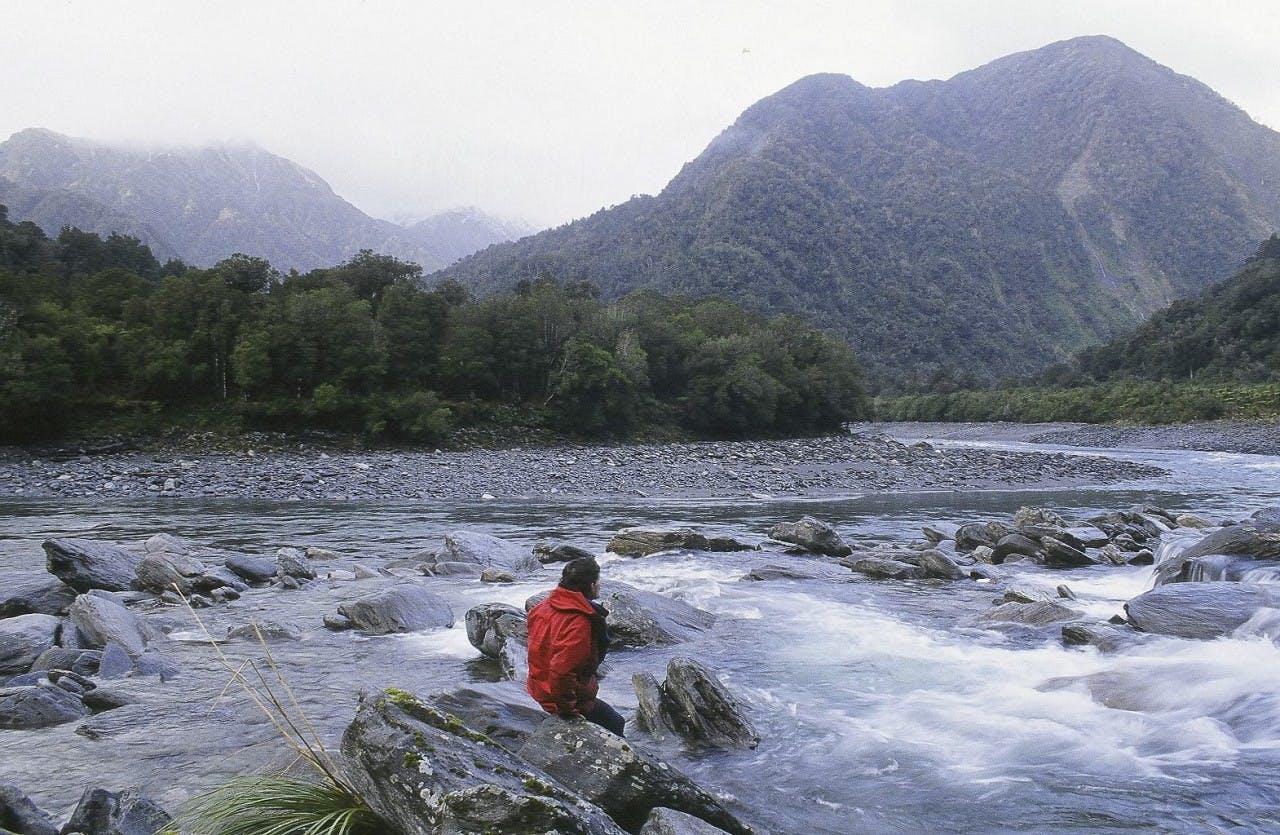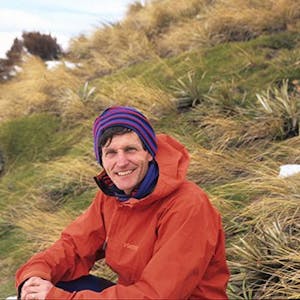Before personal locator beacons, injured trampers had to get word for help out by foot. Pat Barrett recalls one such rescue on an ill-fated tramping club trip
The scream of the twin-prop NAC Fokker Friendship slowly diminished as we glided to a halt at Hokitika Airport. In its place the drum of rain beat the cabin roof.
It was December 1977 and 14 members of the Wellington Catholic Tramping Club were looking forward to the club’s annual Christmas trip – an 18-day traverse through passes and valleys of the Hokitika headwaters.
“The Wellington Catholic Tramping Club has finally arrived,” remarked trip leader Graeme Cooper, 21, to anyone within earshot as we clambered out of the plane.
“And we’re heading for the Alps,” chimed in Ian Maclean, as he cuffed Paul, Graeme’s six-foot-four brother, around the ear in a mock display of seniority.
The party is in high spirits despite the rain and the discovery of Mike Maroney’s ice axe damaged beyond use courtesy of some rough handling by the airline.
A replacement was found in town, but the dilly-dallying and an interminable wait for transport to the Hokitika Gorge, as well as arranging a food drop in the Toaroha Valley, meant we didn’t arrive at the track head until late. We walked a short way up valley to a rundown hut before calling it quits for the day.
The hut was too small for us all so the overflow slept outside. That didn’t bother Brian Collins, who said: “Well lads, it’s great to be here, even in the rain.”
Morning brought respite in the weather but the sky was heavy, pregnant with moisture; the air humid and cloying. The Hokitika River was running high and turgid.
We headed upstream over slippery rocks and numerous side streams, bound for Frew Hut. The cableway just before Rapid Creek Hut took more than an hour for us all to cross. Further on, the Collier Gorge Swingbridge caused major concern for some of the girls. It was slow going. We reached Frew Hut late and in the rain.
At that point, Graeme saw the writing on the wall, or, more specifically, the spread of bodies over kilometres of track: fast ones at the head, average in the middle, and the slow ones far to the back.
A change of tactics was announced and the next day he picked three of us to go ahead and wait at Frew Bivouac, near Frew Saddle, to set up a lunch for the party as they came through. Three teenagers – Paul Cooper, me and Davey Hughes (the Swazi Man as he is known these days) headed off.
Even during those far off days, Davey’s quick wit and endless hunting yarns provided us with plenty of laughs as we tramped through the torrential downpour and chilling wind. Once at the bivvy, we set about making room for our ‘soup kitchen’.
“It’s an emergency,” shouted Davey as he hurled a stool into the rain, closely followed by a few pots and pans, an old mattress, and a sheaf of magazines. Within half an hour we were ready to deliver the meals, but where were our customers?
We peered into the mist, willing them to appear. But there was nothing to see, save for sheets of rain washing the face of the saddle.
It was nearly an hour before the first stragglers came in soaked, cold, and having had great difficulty crossing some of the side creeks which we had crossed with ease just 90 minutes earlier. Things were beginning to take a turn for the worse.
The cold began to creep into our bones while we served the now steady straggle of party members with soup, bread and chocolate. The rain continued as the last of the group wandered in, at which point our roles reversed; we were the needy ones, chilled to the bone, wet, and anxious to get on.
Closing shop, we dropped into the head of the Hokitika River, pleased to be over the pass. But there was still a long way to go to reach Bluff Hut before nightfall. Graeme had urged the three of us: “Get to the hut and come back to help with packs if possible.”
The day was rapidly closing on us and the party spirit was beginning to fade.
The upper Hokitika is not difficult country until you reach the scrubline, below Steadman Creek. A marked track exists here, cutting across the hillside below bluffs bisected with small gullies and numerous slabby rocks, slick and greasy after days of rain. We three passed this section carefully and arrived at the hut just on dusk along with three other exhausted members of the group. If anything, the rain had increased in intensity.
A lightning strike illuminated the dark, followed almost instantly by an ear-splitting thunderclap that shook the hut and brought with it a waterfall of rain. We stare at each other. “Are we really going to venture out in that to get packs?” Paul asked.
Just then, the door flew open and Ian MacLean, looking pale and shocked with water cascading off his parka, appeared.
“It’s Father Bob!” he shouted. “He’s slipped down a slab and dislocated his shoulder.”
We were stunned. Bob Snowden was the club chaplain and arguably the strongest, fittest, and most able member in the party. Powerfully built, no physical challenge ever seemed a problem for him.
Two of the girls entered the hut, giving Ian a chance to catch his breath before continuing: “Graeme and the rest are staying put with him tonight under the tent fly and will bring him down tomorrow.”
That night the storm moved in. Thunder, lightning, and torrential rain flew on the roaring wind. Amongst all the commotion and worry for Bob, we barely slept.
Bob finally made it to the hut the next day. He looked ashen with eyes sunk and hair soaked and clinging to his scalp like strands of kelp. Deep lines of pain etched his normally handsome face and the tell-tale slump of his right shoulder showed his arm was no better.
Unable to talk and worn out from pain and a sleepless night, he took a seat. We tried to relocate his shoulder, but just caused more pain. It was time for a council-of-war.
Without a mountain radio, there was only one way to get help – walk out. Our party was obviously too slow to go as one. A small, fit group was needed. The soup-kitchen trio were on the mat again.
“Will you guys go?” Graeme asked.
“Yep, we’re on,” Paul replied, speaking for Davey and I.
Although we were familiar with the terrain we had just tramped, it’s not the most direct way out from Bluff Hut. That looked to be down the Hokitika Canyon, on the track marked on our inch to the mile map. We had no idea that this track, in official Forest Service jargon, ‘no longer existed’, having been left derelict for decades.
We set off with a few supplies for what we thought would be a quick trip out. Blue sky had appeared through gaps in the cloud.
Feeling empowered with the rescue mission at hand and determined to get out as fast as possible, we made quick work of the 500m descent to the Mungo River. We crossed the footbridge, pushed on to Darby Creek and started up the steep spur to Frisco Hut. An impenetrable barrier of forest, lawyer vines, supplejack and nettles confronted us.
“Where’s the bloody track?” shouted Davey. Submerged in a green tangle was the answer.
There was no option but to keep climbing, fighting our way until we gained Frisco Hut by mid-afternoon.
Frisco sits near the bush edge at a similar height to Bluff Hut, which we could still see. We had barely travelled two kilometres as the crow flies.
The hut was like a museum of Forest Service works in the area with a full complement of cooking pots and Primus equipment, fuel, books, Tilley lamp, and tools, all unused and the hut unvisited for more than 15 years.
The food locker was crammed with an array of canned food. “It’s an emergency, lads,” Davey reminded us and so we helped ourselves to whatever we could eat or carry.
Leaving the hut we avoided Frisco Canyon, one of four major gorges in the Hokitika, but false lead followed false lead as we grappled our way down to Nogo Creek; a mistake here would drop us into the canyon: a frightening thought. At the river, we rested in hot sunshine, pleased to see the water flowing substantially lower.
It was a brief respite, as a feeling of unreality about our mission dogged our thoughts. An hour later we encountered a large bluff, which forced us onto a high sidle through thick bush where we stumbled out into a steep moss-streaked waterway that plummeted 100m into the river.
Paul voiced his concern: “I don’t like the look of that grease-pan.”
I didn’t either. The waterway was wide, almost 20m, canted at 30-degrees and ridged with thick veins of slippery algae. Beyond the slope was the void, making a slip here fatal.
Gingerly we threaded our way over, making use of windfalls and log jams to protect a fall on the treacherous slope, yet some moves had to be made entirely unprotected, relying completely on well positioned and balanced steps on the greasy rock. It was a nerve-wracking passage.
“We’re committed now,” Davey said. “There’s no way I’m going back over that!”
Darkness caught us deep in the gorge at Serpentine Hut, a bright orange box hiding on a thickly-forested terrace above the Hokitika where it surges between the great walls of the canyons. After 14 hours of bush-bashing, we were hardly able to appreciate the uniqueness of the place, nor that we were the first visitors in probably 20 years. We just wanted to rest our aching bodies.
Paul dumped his pack and pushed open the door. Seconds later he ran out, roaring: “Possum! There’s a huge black possum in there!”
It took a while to dislodge it from under the bunks, but a few well aimed rocks and plenty of noise on the hut walls with ice axes convinced it to retreat to the forest.
“Look at the mess that mongrel has made,” exclaimed Davey as we entered. “He’s lucky I didn’t have my rifle!”
The mess was indescribable and the smell even worse. Filth on the bunks, billies and cups upturned, mattresses shredded, fur sticking to piles of excrement on the floor. We slept there anyway, scraping the bunks clean and sweeping off the table top, too tired to consider any other options.
The next day we painstakingly sidled the Omatane, Kawau, and Kakariki canyons through steep country and dense untracked bush.
We were continually bluffed, bruised, scratched, cut, dirty, and exhausted. We pushed on, thankful that the weather was holding, ever focussed on getting out.
“It’s got to end soon,” I said as we descended another slip face onto the river bed.
“Don’t count on it,” Paul replied, “the Hoki’s not finished with us yet.”
Kakariki Canyon was our last high traverse. We climbed onto a bush terrace from where we could make out the confluence with the Whitcombe River and beyond that the main valley track.
“I can see the junction, it’s not far,” Davey called, as we passed a clearing on the terrace.
We shouted in relief, but our celebration was premature. The descent back to the river was difficult as a vertical scarp surrounded much of the downstream side of the terrace. Perseverance won out in the end as we located a safe exit point through a shallow gully off the ridge, finally falling out of the bush into the bed of New Year Creek at the end of the gorge. It was a fitting exit point; the date was December 31.
“What a gut-busting route that was,” I sighed.
“Yeah but the emergency ain’t over yet,” Davey reminded us.
Another hour of rough riverbed travel got us to the Rapid Creek Cableway and, at last, the track. Help was near, but we still had to reach the first farmhouse, some eight kilometres beyond the end of the track. It was an interminable road walk as we plodded on bone-weary feet, passing the rain gauge hut where we had sheltered just days earlier and out onto the lower river flats.
Even today, 36 years later, I can still savour the exquisite moment of sheer relief when we marched up the gravel driveway to the farmhouse and thumped loudly on the door.
The farmer’s wife, a tall, plump lady greeted us with a cheery, “Hallo lads, you look like you could use a cuppa and a scone or two!”
Sitting down in the comfort of the farm kitchen was unreal. The police were called and we knew we could finally pass on the burden of responsibility.
The news from the phone was not good though. “They can’t fly till tomorrow. It’s too late and all the pilots are, well, you know where,” our host said, reminding us it was New Year’s Eve.
Bob was flown to Greymouth Hospital at dawn. He cried when the chopper came, having not slept much during the past four days. With his heli-vac came a request from Graeme; the remainder of the party would continue over to the Toaroha where he wanted us to meet them at the road end with the food drop. The plan was to re-group and continue the trip.
Arriving by van at the Toaroha we found a suitable barn and set up our camp inside to await the group. It was to prove a long wait, three days of interminable restlessness at the barn as the rain continued and the sandflies bit. By lunch on the first day, the temptation of all the fresh food we were minding proved too much, particularly the cake, sweets and beer. The ‘emergency cry’ was raised once again, and we tucked in.
“It’s not right that all this good food should be left to waste,” said Davey as he bit into a large piece of Christmas cake.
On the third afternoon, through the rain and mist, we spied a solitary figure approaching. It was Graeme. “Hi lads, I’ve got a little mission for you,” he said. “Helen has sprained her ankle up the valley. Can you go on up and help bring her down?”
Gob-smacked we looked at each other and muttered: “It’s an emergency!”
Postscript
A day later the entire party, minus Bob, who never regained full use of his arm, re-grouped at the road end barn where some pointed questions were asked about treats, supposedly contained in the food drop. One half of the party was not talking to the other, several members were nursing sprains and scrapes and looking thoroughly dejected. Any thought of continuing was abandoned.
A night was spent in Hokitika following which Graeme informed the most rebellious party members, including the rescue trio, that they could find their own way to Christchurch and had better be there in time for the scheduled sailing to Wellington as he had the group booking.
A year or two later, another club Christmas trip had an injured member with a broken ankle flown out of the Landsborough, this time we had a mountain radio.
Recently I spoke with Graeme and he voiced his utter dismay in trying to cope with the demands of this trip. “My concerns were just overwhelming for the young fella I was at the time,” he said. “I was glad when it was over.”








